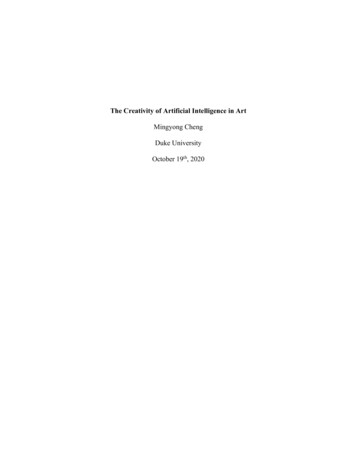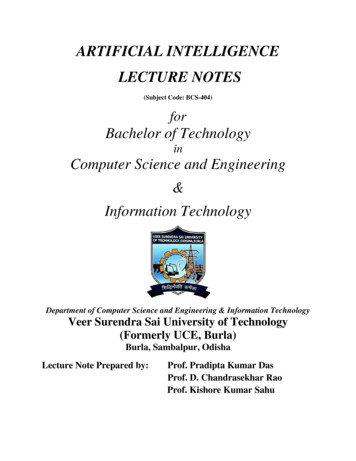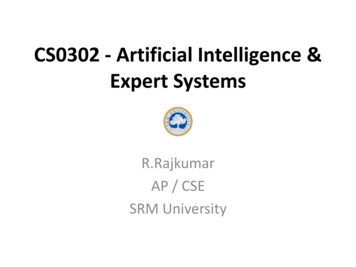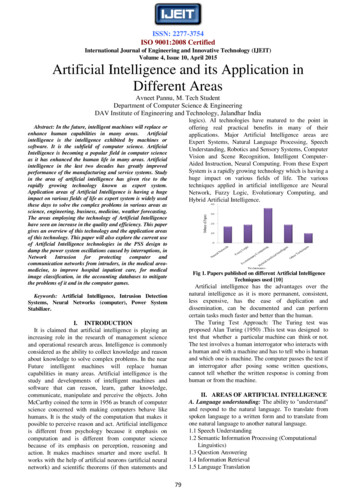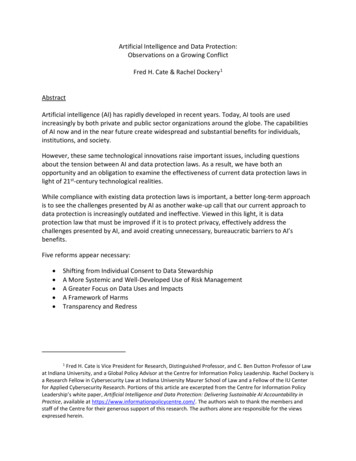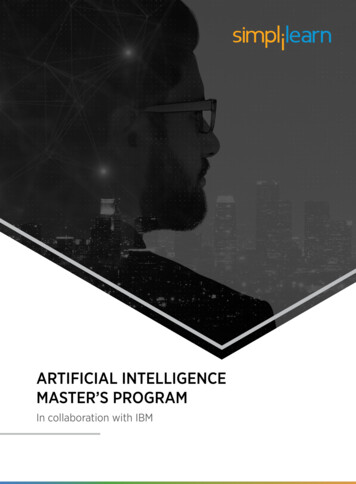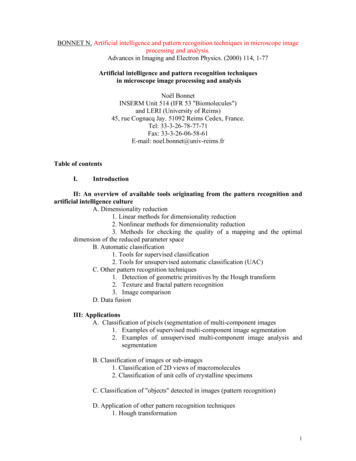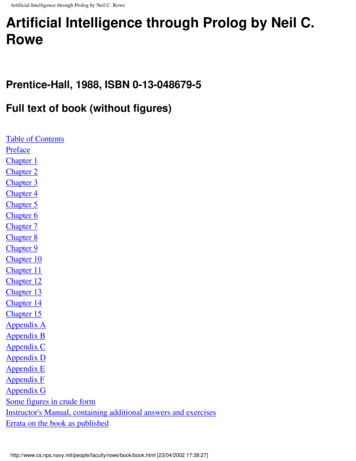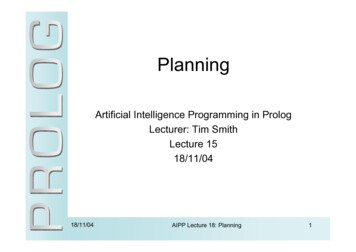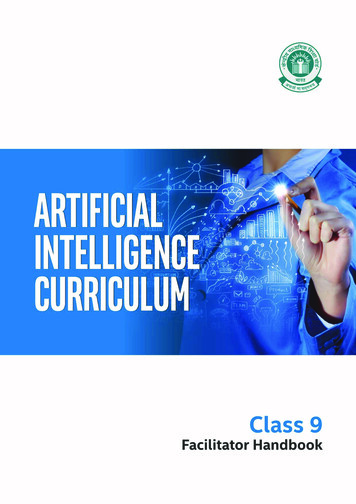
Transcription
ARTIFICIALINTELLIGENCECURRICULUMCurated with support from Intel
AcknowledgementPatrons: Sh. Ramesh Pokhriyal 'Nishank', Minister of Human Resource Development, Governmentof India Sh. Dhotre Sanjay Shamrao, Minister of State for Human Resource Development,Government of India Ms. Rina Ray, IAS, Secretary, Department of School Educa on and Literacy, MinistryHuman Resource Development, Government of IndiaAdvisory, Editorial and Crea ve Inputs: Ms. Anita Karwal, IAS, Chairperson, Central Board of Secondary Educa on Ms. Shweta Khurana, Director, Corporate Affairs Intel IndiaGuidance and Support: Sh. Anurag Tripathi, IRPS, Secretary, Central Board of Secondary Educa on Dr. Joseph Emmanuel, Director (Academics), Central Board of Secondary Educa on Dr. Biswajit Saha, Director (Skill Educa on & Training), Central Board of SecondaryEduca onValue adder, Curator and Co-ordinator: Sh. Ravinder Pal Singh, Joint Secretary, Department of Skill Educa on, Central Board ofSecondary Educa onContent Cura on Team: Ms. Sharon E. Kumar, Innova on and Educa on Consultant, Intel AI4Youth Program. Ms. Ambika Saxena, AI Coach, Intel AI4Youth Program Ms. Shyda Rana, Senior Faculty, Army Welfare Educa on Society
About the BookAr ficial Intelligence (AI) is being widely recognized to be the power that will fuel the futureglobal digital economy. AI in the past few years has gained geo-strategic importance and a largenumber of countries are striving hard to stay ahead with their policy ini a ves to get theircountry ready.India's own AI Strategy iden fies AI as an opportunity and solu on provider for inclusiveeconomic growth and social development. The report also iden fies the importance of skillsbased educa on (as opposed to knowledge intensive educa on), and the value of projectrelated work in order to “effec vely harness the poten al of AI in a sustainable manner” and tomake India's next genera on 'AI ready'.As a beginning in this direc on, CBSE has introduced Ar ficial Intelligence as an op onal subjectat Class IX from the Session 2019-2020 onwards. To enhance the mul disciplinary approach inteaching learning and also to sensi ze the new genera on, it was decided that Schools may startAI “Inspire module” of 12 hours at Class VIII itself.CBSE is already offering various Skill subjects at Secondary and Senior Secondary level toupgrade the skills and proficiency of the young genera on and also to provide them awarenessto explore various career op ons. At Secondary Level, a Skill subject may be offered asaddi onal sixth subject along with the exis ng five compulsory subjects.CBSE acknowledges the ini a ve by Intel India in cura ng this Facilitator Manual, the AI trainingvideo and managing the subsequent trainings of trainers on the Ar ficial IntelligenceCurriculum.The aim is to strive together to make our students future ready and help them work onincorpora ng Ar ficial Intelligence to improve their learning experience.
ContentsConceptual FrameworkIntroduction to Artificial Intelligence3Rationale4The Purpose4Overview of the AI CurriculumOverview and Learning Objectives of the AI Program56Essential Learning Experience from AI6Developing Key Competencies for Lifelong Learning6The AI CurriculumSchool Procedures for AI Implementation7AI Implementation Procedures7AI SyllabusUnit wise DistributionAssessment889Suggestive Assessment Approaches for AI9AI Curriculum MappingInterdisciplinary Integration with Artificial Intelligence - Class IX1010AI Learning Indicators11Translating AI on Ground1313131313Creating the MindsetPreparatory GroundworkFacilitating and FeedbackMentoring and MonitoringUnit 11.1 ExciteIntroduction to AIDream Smart HomeActivity – Game TimeQuiz Time: AI QuizActivity: Letter to Future Self1.2 RelateFloorplan ActivityCreating a Story: Are you a good Storyteller?1.3 PurposeSustainable Development GoalsGo Goals:1414161823242626303434361
1.4 PossibilitiesGroup Activity: Research on current AI TrendsPoster Making – Job Advertisement for 2029!1.5 AI EthicsActivity – Watch the video AI for Good.Balloon Debate404146494950Unit 2AI Project CycleAI Project Cycle – Defined!2.1 Problem ScopingGetting Started4Ws Problem CanvasProblem Statement Template2.2 Data AcquisitionWhat is Data Acquisition?Data FeaturesAcquiring Data from reliable sourcesSystem Maps2.3 Data ExplorationLet us exploreSketchy Graphs2.4 ModellingAI, ML & DLModellingRule Based ApproachLearning Based ApproachDecision TreeDo It Yourself!Pixel It53565858626466676869707475798283858687889194Unit 3Neural NetworksNeural Networks – DefinedNeural Networks Vs Human Nervous SystemHuman Neural Network – The GameCo-Curricular ActivitiesAnnexure98101103104111112All curated material has been responsibly sourced online or purchased2
Conceptual FrameworkIntroduction to Artificial IntelligenceArtificial Intelligence has always been a term which intrigues people all over the world.Various organisations have coined their own versions of defining Artificial Intelligence. Someof them are mentioned below:Niti Aayog: National Strategy for Artificial IntelligenceAI refers to the ability of machines to perform cognitive tasks like thinking, perceiving,learning, problem solving and decision making. Initially conceived as a technology that couldmimic human intelligence, AI has evolved in ways that far exceed its original conception. Withincredible advances made in data collection, processing and computation power, intelligentsystems can now be deployed to take over a variety of tasks, enable connectivity and enhanceproductivity.World Economic ForumArtificial intelligence (AI) is the software engine that drives the Fourth Industrial Revolution.Its impact can already be seen in homes, businesses and political processes. In its embodiedform of robots, it will soon be driving cars, stocking warehouses and caring for the young andelderly. It holds the promise of solving some of the most pressing issues facing society, but alsopresents challenges such as inscrutable “black box” algorithms, unethical use of data andpotential job displacement. As rapid advances in machine learning (ML) increase the scopeand scale of AI’s deployment across all aspects of daily life, and as the technology itself canlearn and change on its own, multi-stakeholder collaboration is required to optimizeaccountability, transparency, privacy and impartiality to create trust.European Artificial Intelligence (AI) leadership, the path for an integrated visionAI is not a well-defined technology and no universally agreed definition exists. It is rather acover term for techniques associated with data analysis and pattern recognition. AI is not anew technology, having existed since the 1950s. While some markets, sectors and individualbusinesses are more advanced than others, AI is still at a relatively early stage of development,so that the range of potential applications, and the quality of most existing applications, haveample margins left for further development and improvement.Encyclopaedia BritannicaArtificial intelligence (AI), the ability of a digital computer or computer-controlled robot toperform tasks commonly associated with intelligent beings. The term is frequently applied tothe project of developing systems endowed with the intellectual processes characteristic ofhumans, such as the ability to reason, discover meaning, generalize, or learn from pastexperience.3
In other words, AI may be defined as:AI is a form of intelligence; a type of technology and a field of study. AI theory anddevelopment of computer systems (both machines and software) are able to perform tasksthat normally require human intelligence. Artificial Intelligence covers a broad range ofdomains and applications and is expected to impact every field in the future. Overall, itscore idea is building machines and algorithms which are capable of performingcomputational tasks that would otherwise require human like brain functions.RationaleSchools have an important and responsible role to provide learning opportunities for thestudents and guide them on the path to success. There is need to channelize learning towardsapplying innovative skills and application that will contribute towards a robust future in asustainable world.A school is recognized because of the capability of its teachers to bring out the best in thestudents. Students are the ones who will shape the future of the country – they are the oneswho need to pave the way to sustainable development and to preserve the planet.Much aligned to this are the sustainable development goals (SDG) that focus on the wellbeing of the planet and teachers have the role of introducing these SDGs to the students.Students also need to be guided on recognizing the pros and cons of Artificial Intelligence andon being able to differentiate between what is right and acceptable and what is not.The PurposeArtificial intelligence is gaining the spotlight across applications in our personal andprofessional lives. We need to take charge of preparing ourselves and our students for thefuture. Hence, Central Board of Secondary Education (CBSE) has decided to introduce artificialintelligence as an elective subject.4
Uniqueness of the ProgramSkill SetMind SetImmersiveInclusiveReal ExperiencesHuman ContextHands-onMachine ContextEmpowermentOverview of the AI CurriculumArtificial Intelligence Curriculum aims at developing the learner’s mind set and skills settowards artificial intelligence and how it is understood and applied. The important principlethat artificial intelligence embraces is holistic inclusive and progressive development inimmersive ways by problem solving, creative thinking, and critically analysing data.5
Overview and Learning Objectives of the AI ProgramPedagogy for AIPedagogical Approach – Hands on – Activity Based , Experiential learning , Inquiry Based learning Three dimensions of learning –Knowledge – Concepts –( Ability to Know) - Age appropriate Specific AI conceptsSkills-(Ability to Do) - Skills to be acquired during the Activity , Experiential PhaseAttitude – (Inculcating appropriate behaviour & life Skills ) – Developing ethics in learning AI Developing Thinking Skills , Social Skills & Emotional SkillsDeep Understanding of AIThe process of deep understanding will require a conceptualbuilding.The learning JOURNEY will take a course from simple to complex &Known to unknown .The AI Learning Modules are age appropriatewith specific learning outcomesAge Appropriate ModulesClass 8InspireCreate Solutions with AI forsocial ImpactPedagogy- InterdisciplinaryIntegration / Theme BasedProjectAge Appropriate ModulesClass 9AcquireAge AppropriaateModulesClass 10 /11ExperienceEssential Learning Experience form AIThe core essential learning experiences from the AI course are Experiences of creating by Identifying Problem solving Experiences of Informed decision making Experiences of demonstrating responsible citizenship Experiences of self-reflection, values and ethics. Experiences for exploring future career opportunitiesDeveloping Key Competencies for Lifelong Learning Learning and problem solvingDeveloping interaction and cooperationInnovativeness and initiativeApplication across key disciplinesSocial responsibilities and applicationsVocational ethicsCommunication skills6
The AI CurriculumSchool Procedures for AI ImplementationSchooladministration’sapplication toCBSE forapprovalTeacherselection,training andsustainedmotivationStrategy andplanning for AITime table jects andShowcasingAI Implementation ProceduresAI SensitizationFor PrincipalsCurriculumIntegrationSyllabusPedagogy &ApproachSchoolLevelCBSELevelAIPlanning Modalities forSchool ImplementationSchoolLevelTraining ofTeachers in AIIn ionale of AIFor Learning Beyond7
AI SyllabusUNITWISE DISTRIBUTIONMARKSNo.12UNITSUB-UNITExcite2.4 Hours (4 Periods)Relate02 Hours (3 Periods)Purpose02 Hours (3 Periods)Possibilities02 Hours (3 Periods)AI Ethics3.6 Hours (6 Periods)Problem Scoping14 Hours (21 Periods)Data Acquisition02 Hours (3 Periods)Data Exploration04 Hours (6 Periods)Modelling06 Hours (9 Periods)Introductionto AIAI Network04 Hours (6 Periods)10104Introductionto Python70 Hours(105 Periods)20105Co-curricularSkillsTOTAL10112 Hours(168 Periods)50508
ASSESSMENTAfter completion of each unit, the students can be evaluated on the basis of the followingskills:Suggestive Assessment Approaches for AIAI ThemeProject Class TopicOralFeedback toStudents &parentsWho WillAssess?WrittenContent,Skills,Life SkillsObservationsTechniquesHow will AIbe assessed?What is to beassessed?9
AI Curriculum MappingAI integration in the curriculum can be done in the following ways: Interdisciplinary approachacross Subjects based on a selected theme.Interdisciplinary Integration with Artificial Intelligence - Class 9AI Integration usingGoogle Story SpeakerAI Integration usingComputer VisionEnglishScienceWrite a newspaper article suggesting strategiesHiger yields of foodto improve the food production in the country.What do we do to get higher yields in ourA discussion - "With the populationrise in India farms?more farmland areas is needed, while India isCase study - Why can we not make do with thealready intensively cultivated "Do you thinkcurrent levels of agriculture production?Aritificial Intelligence is the way to solve thisproblem?"Theme class 9ScienceChapter 15Improvement in Food ResourcesGeographyDoes climate inpact gain production? How canyou suggest ways to predict the climate andprotect crop? What are the ideas you suggestfor improving the natral irrigation system?AI Integration using NaturalLanguage ProcessingMathematicsProblem Solving - Considering the population ofIndia is more than 1 billion people and we needa quarter of a billion tonnes every year, whatdata will you collect to present your researchreport?AI Integration usingData Exploration10
AI Learning IndicatorsAreasClass 8Class 9KnowledgeUnderstanding AIWhat is AI?Why?Pedagogy- Brainstorming/Conceptmaps, Venn DiagramsSkillsPrerequisite skillsSkills to beacquired/developedInquiry / Questioning SkillsGenerating Ideas – Critical &Computer skillsWhy AI /Why not AI ?What other , NLR- ComparisonMatrixInquiry / Questioning SkillsCommunicatingCreative thinkingCritical ThinkingTechnicalCompetencies forArtificial Intelligence(AI)DataComputer Vision(CV)Natural LanguageProcessing (NLP)Through Creative games /Skillsbased problem solving challenges/DesigningIntroduction to all three domainsDataCVNLPUsing all three domains in differentchallenging games to identify AI indifferent contextThrough Creative games /Skillsbased problem solving challenges/DesigningBuilding conceptual understandingand skill development in one domainof AI DataCVNLPGaining competency in NLP.Learning basics of PythonAttitudeInitiativePositive ThinkingInitiativeSuccess Vs failurePositive ThinkingLife Skills to bedevelopedThinking SkillsSocial SkillsThinking Skills /Social SkillsEmotional SkillsProgram course to becoveredMentoring andfeedbackSuggestive ActivitiesIn one academic sessionIn one academic sessionFace to faceOnlineOnline Newsletter for all levels onthe work in AI all across participatingschoolsFace to faceOnlineOnline Newsletter for all levels onthe work in AI all across participatingschools11
AI Learning OutcomesAreasUnit 1.1: ExciteClass 8After completion of the unit,learners will be able to describe:Class 9After completion of the unit,learners will be able to describe:Introduction to ArtificialIntelligenceThe relation and application ofAI in their daily lifeThe relation and application of AIin their daily lifeThree domains of AIIdentify the 3 domains of AIIdentify the 3 domains of AIUnit 1.2: RelateLearners will be able to relate tothe relevance and application ofAI in the context of their homesLearners will be able to relate tothe relevance and application of AIin the context of their homesSmart home and CitiesLearners will be able to extendlearning and apply it tointeractive story writingLearners will be able to extendlearning and apply it to interactivestory writingLearners will be able to identifyand develop awareness forSDGs using AI solutionsLearners will be able to identifyand develop awareness for SDGsusing AI solutionsLearners will be able to describeand explore the application ofAI in different fields and variousindustriesLearners will be able to describeand explore the application of AI indifferent fields and variousindustriesLearners will be able to describesome ethical concerns of AI withrespect to inclusion, bias, andprivacyLearners will be able to describesome ethical concerns of AI withrespect to inclusion, bias, andprivacyInteractive story writingUnit 1.3: PurposeIntroduction to 17 sustainabledevelopment goalsUnit 1.4: PossibilitiesApplications of AI in variousfieldsUnit 1.5: EthicsIntroduction to EthicsAwareness to EthicsUnit 2: AI project cycleIntroduction to AI Project CycleProblem ScopingData AcquisitionData ExplorationModelling: AI, ML, DLEvaluationUnit 3: Neural NetworksIntroduction to the concepts ofNeural NetworksAfter completion of the AI projectcycle learners will be able to:Describe, explain and apply thedifferent stages in project cycleEnquire about and state theproblem for the project cycleand create a system mapUnderstand different ways for dataacquisition and interpretationthrough graphs and visualsModel and evaluate the problemfor the project cycleRecognise different type of graphsand explore various patterns andtrends out of the data exploredLearners will be able to develop anunderstanding of Neural NetworksLearners will be able to describethe working of Neural Networks12
Translating AI on GroundCreating the MindsetThe aim is to familiarize students into understanding the AI Program. The foundation on whichAI is built upon is Patterning; Data interpretation; Sorting; Comparing; Classifying; Identifying.The AI Applications that surround us are proof of innovation using technology. We need toprepare ourselves to unlearn, learn and relearn!Preparatory GroundworkReading and gathering all information one can get about what is AI and what is not - isimperative for a better understanding of the subject. Be prepared to connect to new learningon the basis of your previous knowledge. – Read, Research, inquire, ask questions, watchvideos, talk for and against AI, walk through Malls, airports, hospitals and try to figure outwhat is AI and what is not.Facilitating and FeedbackLearning to Facilitate is learning to know the difference between when to guide/suggest andwhen to allow students to figure out and understand for themselves, question, hypothesizeand take the challenge.Being a Facilitator is mostly about how to motivate, encourage and simplify.Learning to use appropriate vocabulary while giving feedback is the skill set most required bya Facilitator. Give feedback in a positive manner to inspire students to explore and perseverein their learning.Mentoring and MonitoringEnsure that continuity is maintained in mentorship and monitoring to facilitate students’learning. Online feedback, Interactive discussions on problems and challenges are some ofthe ways to assist this.Facilitator Instructions for each activity can be found in such Boxesthroughout the manual.13
Unit 11.1 ExciteFacilitator GuideTitle: ExciteApproach: GameSummary: Students will play a few games that involve AI technology and computerapplications. Consequently, they will learn about the 3 Domains of AI and do a quiz andreflection about this session.Objectives:1. Students get their first taste of what problems Artificial Intelligence can solve andbecome excited about learning the technology behind it.2. Gain the habit of solving problems by practicing critical thinking and self-directedlearning.3. To discover more about themselves and their friends.Learning Outcomes:1. Describe application of AI in their daily lives.2. Identify the 3 domains of AI.Pre-requisites: Basic computer literacyKey-concepts: 3 Domains of Artificial IntelligenceIntroduction to AIPurpose: Introduce the program to students.Say: “The Artificial Intelligence Curriculum hopes to inspire AI-Readiness in you. At the endof this program, we hope you will get a deep understanding of AI, access to AI-poweredtools and the ability to create solutions with AI.”Ask the students to answer the questions that follow. Let them write their own viewswithout any guidelines or instructions. After filling the questionnaire, discuss the answerswith the whole class so that you get to know what their expectations are regarding the AIcurriculum.Welcome to an Introduction to Artificial Intelligence!What do you think Artificial Intelligence is?What do you want to learn about AI?14
How do you think we should go about it?What will you learn?AI is a form of intelligence; a type of technology and a field of study.AI theory and development of computer systems (both machines and software) are able toperform tasks that normally require human intelligence.Artificial Intelligence covers a broad range of domains and applications and is expected toimpact every field in the future.Overall, its core idea is building machines and algorithms which are capable of performingcomputational tasks that would otherwise require human like brain functions.How do you think Artificial Intelligence can help you as you go about your daily life? Fill inyour ideas below:ArtificialIntelligence15
Dream Smart HomeSession PreparationLogistics: For a class of 40 Students. [Individual Activity]Materials Required:ITEMQUANTITYA4 Sheets40Sketch-pens 40Purpose: Icebreaker activity to get the students excited towards the AI curriculum.Say: “We want to get to know you better. Home is where your heart is. Your home willalways be the place for which you feel the deepest affection, no matter where you are.Draw a floorplan of your dream home. Does it have a swimming pool or does it have aplace for you to indulge in your favourite hobby. Or if you like gardening. Do you have agarden indoors or outdoors? Imagine you can look down from above at all the spaces inyour dream home. What does it look like? Draw it out!”Congratulations! You have just won the opportunity to design your Dream Home!16
If you could design your home, what would your ideal home look like? Would it have someunique features other than the existing Drawing Room Kitchen Bedrooms etc.? Would it havea swimming pool? A garden - indoors or outdoors? A hobby corner? What if your home couldfollow all your commands? What are the luxuries that you can include?Design a layout of a floor plan of your dream smart home.Include any gadgets or devices that you think will make it unique or “smart”.Floor Plan of My Dream Smart Home17
Activity – Game TimeSession PreparationLogistics: For a class of 40 Students [Pair Activity]Materials Required:ITEMAI Game CluesComputersHeadphones (With Microphone)WebcamsQUANTITY20202020Resources:Link for Game 1 (Rock, Paper and Scissors): rsLink for Game 2 (Mystery Animal): ink for Game 3 (Emoji Scavenger Hunt): https://emojiscavengerhunt.withgoogle.com/Games are an integral part of our culture. People across theworld participate in different kinds of games as a form of socialinteraction, competition and enjoyment.The basic principle of every game is rule setting and following therules.Write down three rules in the given spaces you would set before playing any games?Rule 1Rule 2Rule 318
Purpose: The purpose of this section is to expose students to the 3 domains of AI (NaturalLanguage Processing, Computer Vision and Data for AI).Brief: [Pair Activity] Students will go through three AI games in the form of a challenge.The link for each challenge will be printed on small slips and given to the students oneafter the other. They have to finish all the three challenges within an hour.Game Descriptions:Rock, Paper & Scissors: A game based on Data for AI where the machine tries to predictthe next move of the participant. It is a replica of basic rock, paper and scissors gamewhere the machine tries to win ahead by learning from the participant’s previous moves.Mystery Animal: A game based on Natural Language Processing where the participant hasto guess the animal by asking maximum 20 questions to AI. The animal randomly getsselected for each game by AI and the machine replies in either yes or no.Emoji Scavenger Hunt: A game based on Computer Vision where the machine initiates thegame by showing an emoji. The participant is expected to show a similar object in-front ofthe camera while the machine keeps on guessing what is being shown to it.When to intervene?Rock, Paper & Scissors: Ask the students to see how does the machine react if they 1. Makemoves in a specific pattern, 2. Make moves randomly.Mystery Animal: Ask students to figure out basic characteristics of the animal by askingquestions like “Can you swim?”, “Are you a carnivore?”, “Are you a mammal”, etc.Emoji Scavenger Hunt: Ask them to try new things like drawing the emoji on paper andshowing it to the machine.Say: “We are going to get serious now! You are challenged by an eccentric data scientist,to solve 3 challenges he designed. You have 60 mins before he inserts a virus in everyelectronic device in the world! We will work in groups of 4-5 group Students now .Whether you are ready or not, the countdown is going to start now! Grab a seat in frontof the computer and start your challenge. [Pass every group a mission card]”19
The AI Game Challenge –Guess what ? Here are some visuals that will help you guess the games you are going to play, Youhave 10 seconds to guess and write the name of the games below:Guess the game.Have you tried it before?Guess the game.Have you tried it before?Guess the game.Have you tried it before?20
Pair Activity:Team up with a partner and let the challenge begin! Game 1: Rock, Paper and Scissors (based on Data)List the different sources fromwhere you can collect data?Write three things you learnt from the game? Game 2: Mystery Animal(based on Natural Language Processing - NLP)aWhat is Natural LanguageProcessing?Mention three things you understood about thegame? Game 3: Emoji Scavenger HuntWhat is Computer Vision?(based on Computer Vision – CV)Did you face any difficulty while playing this game?How did you overcome this?21
Let’s DiscussWhy should these three games be relevant for AI awareness?Group Activity: Reflect and Analyse:Session PreparationLogistics: For a class of 40 Students [Individual Activity]Materials Required:ITEMThree Different Coloured Stands of Thread(50 cm each)QUANTITY40 each colourPurpose: To understand how three AI domains are inter-related to each other.Students will get to know that even if these three domains of AI – Natural LanguageProcessing, Computer Vision and Data for AI are quite distinct from each other, theytogether constitute the concept of Artificial Intelligence.Take three different colour strands and work them into a braid. See how long your braid canbecome within 30 seconds!! Ready? Go!!!Let’s understand: To understand AI we draw an analogy from the three strands in a braid.One is the Data strand, the second is the Natural Language Processing strand and the thirdstrand is the Computer Vision. They all together constitute the concept called ArtificialIntelligence.22
Quiz Time: AI QuizSession PreparationLogistics: For a class of 40 Students [Pair Activity]Materials Required:ITEMComputersQUANTITY20Brief:The following are questions for the quiz. You can either go for a Pen/Paper Quiz or youcan visit any open-sourced, free, online portal; one of which is Kahoot, and create yourquiz there.For Kahoot: Got to https://kahoot.com/ and create your login ID on it. Then, add your ownkahoot in it simply by adding all the given questions into it. Once created, you can initiatethe quiz from your ID and students can participate in it by putting in the Game pin.Quiz Questions:1. Which one of the following is an application of AI?a. Remote controlled Droneb. Self-Driving Carc. Self-Service Kioskd. Self-Watering Plant System2. This language is easy to learn and is one of the most popular language for AI today:a. C b. Pythonc. Rubyd. Java3. Which of the following is not a stage in the AI Project Cycle:a. Problem Scopingb. Data Acquisitionc. Data Explorationd. Prototyping4. This field is enabling computers to identify and process images like humans do:a. Face Recognitionb. Model-view-controllerc. Computer Visiond. Eye-in-Hand System5. What does NLP stand for in AI?a. Neutral Learning Projectionb. Neuro-Linguistic Programmingc. Natural Language Processingd. Neural Logic Presentation23
6. This is a program that allows the computer to simulate conversation with a humanbeing:a. Speech Application Program Interfaceb. Chatbotc. Voice Recognitiond. Speech Recognition7. This is a system of Programs and Data-Structures that mimics the operation of thehuman brain:a. Intelligent Networkb. Decision Support Systemc. Neural Networkd. Genetic Programming8. Where is Decision tree used?a. Classification Problemb. Regression Problemc. Clustering Problemd. Dimensionality Reduction9. What does model. Add (dense(32, input shape (784))) do?a. It adds an input layerb. It adds a hidden layerc. It adds an output layerd. It adds a dense layer10. How excited are you about this AI curriculum?a. Very Excited!b. A bit excitedc. Same as alwaysd. Not excited at allAI Quiz (Paper Pen/Online Quiz)Quiz to be conducted by the facilitator/teacher.Activity: Letter to Future SelfSession PreparationLogistics: For a class of 40 students [Individual Activity]Materials Required:ITEMA4 SheetsQUANTITY40Purpose: To capture students curr
About the Book Arficial Intelligence (AI) is being widely recognized to be the power that will fuel the future glob
